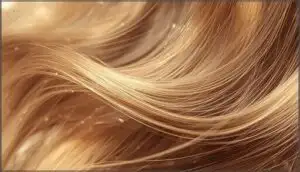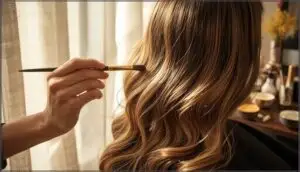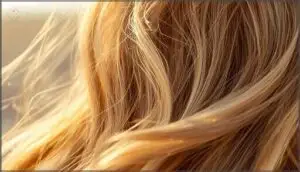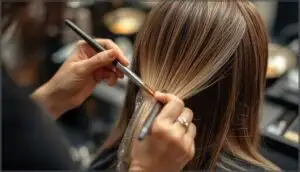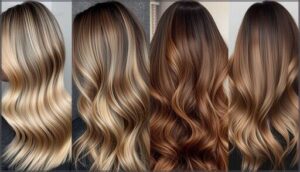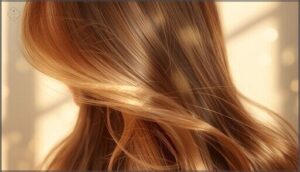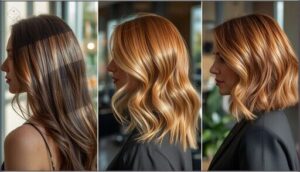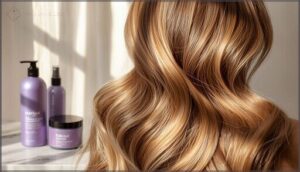This site is supported by our readers. We may earn a commission, at no cost to you, if you purchase through links.

Your colorist sweeps through impossibly thin sections of hair—so fine you can barely see them—and suddenly your whole look transforms without anyone being able to pinpoint exactly what changed. That’s the magic of babylights hair, a technique that’s revolutionized how we think about highlights.
Unlike the chunky streaks that dominated salons a decade ago, babylights use ultra-delicate strands to mimic the soft, dimensional glow you’d get from spending summer at the beach. The result? Hair that catches light from every angle, adds natural-looking depth, and grows out so seamlessly you won’t find yourself stuck in an endless cycle of touch-ups.
Whether you’re working with dark brunette or pale blonde, this precision highlighting method complements your natural color rather than overpower it.
Table Of Contents
Key Takeaways
- Babylights use ultra-fine hair strands (less than 1/8 inch) to create subtle, sun-kissed dimension that grows out seamlessly and requires touch-ups only every 8-12 weeks, making them significantly lower maintenance than traditional highlights.
- This technique causes up to 40% less cuticle damage and 22% less protein loss compared to standard highlighting methods, while creating the illusion of 30-40% more hair thickness through strategic light-catching placement.
- The precision foil application works across all hair types, textures, and colors—from jet black to platinum blonde—allowing colorists to customize placement and tone to complement your natural base rather than overpower it.
- Maintaining babylights requires sulfate-free shampoos, weekly purple toning for blondes, heat protectant before styling, and avoiding hot water rinses to prevent brassiness and extend color vibrancy between salon visits.
What Are Babylights Hair?
If you’ve been scrolling through hair inspiration feeds, you’ve probably noticed babylights popping up everywhere. They’re one of those techniques that sounds fancy but actually delivers something beautifully simple: natural-looking, sun-kissed color that doesn’t scream “I just came from the salon.”
Let’s break down what makes babylights different and why they’ve become such a go-to for clients who want that natural glow.
Definition and Key Features
Babylights are ultra-fine strands of highlights, much thinner than traditional ones, creating a subtle, natural effect that mimics sun-kissed hair. This low-maintenance color technique adds striking hair dimension through a careful process of weaving delicate sections throughout your head.
Think of them as those gorgeous, naturally-looking dye job results you’d get from endless summer days—except achieved with precision foil work that creates barely-there brightness. They’re designed to create a natural look with a delicate effect.
History and Popularity
Hair lightening started way back with Ancient Lightening methods—think Greek women and lemon juice—but modern foil highlights emerged in the 1980s. Babylights truly took off in the 2010s when Celebrity Influence sparked Market Demand for subtler hair highlighting.
This technique offers a more delicate version of traditional highlights. You can thank social media for making these hair color trends mainstream.
With Future Growth predicted in hair color inspiration, babylights aren’t going anywhere as summer hair trends continue evolving.
Sun-Kissed, Natural-Looking Effect
The real magic happens when you see how babylights create that sunkissed hair effect everyone craves. These subtle highlights mimic the way sunlight naturally lightens strands—think childhood summers at the beach.
The subtle lightening adds natural dimension without harsh lines, giving you a youthful appearance that looks natural. It’s the most natural-looking dye job because the fine weaving technique creates sun-kissed realism that flatters every face.
How Are Babylights Applied?
Getting babylights isn’t as simple as slapping some color on and calling it a day. The technique requires precision, the right products, and honestly, a steady hand.
Let’s walk through how this delicate process actually works, from the salon chair to whether you can pull it off at home.
Step-by-Step Application Process
Getting babylights starts with a consultation to assess your natural color, texture, and desired brightness. Your colorist sections hair into ultra-fine strands using a weaving technique, then applies lightener with a precise foil technique.
Processing time varies based on your hair’s starting point. Once lifted, the lightener is rinsed, and toning techniques neutralize any brassiness, leaving you with that coveted sun-kissed finish.
Tools and Products Used
Your colorist reaches for specialized application tools and lightening agents to create those delicate strands. Fine-tooth tail combs weave out hair thinner than a strand of spaghetti, while ultra-thin foils isolate each section. The magic happens with:
- Powder lighteners enhanced with bond builders like Olaplex to prevent hair damage
- Cream-based formulas lifting color gently, up to 7-9 levels
- Toning products and hair gloss treatments that neutralize brassiness and seal in shine
These hair care products and hair styling tools work together for proper hair color maintenance.
Professional Vs. At-Home Techniques
When choosing between a salon visit and DIY babylights, you’re weighing more than just cost. Professional hair services deliver precision that at-home highlighting kits rarely match—think pencil-thin sections versus chunky streaks.
| Aspect | Professional Services | At-Home Kits |
|---|---|---|
| Application Precision | Fine sectioning, undetectable blending | Uneven, harder to control |
| Cost Discrepancies | $150-$550 depending on length | Under $50 initially |
| Quality Outcome | Natural sun-kissed finish (8.8/10 satisfaction) | Often requires correction |
Hair health and maintenance needs tip the scales toward professional hair color application for lasting results.
Babylights Vs. Other Highlighting Methods
If you’ve been wondering how babylights stack up against other popular coloring techniques, you’re not alone. The good news is that understanding the differences doesn’t require a cosmetology degree.
Let’s break down how babylights compare to traditional highlights, balayage, and lowlights so you can figure out which option works best for your hair goals.
Babylights Vs. Traditional Highlights
If you’ve ever wondered what makes babylights different from traditional highlights, you’re not alone—it’s one of the most common questions I get asked at the salon. While both are hair highlighting techniques, babylights create ultra-fine, delicate strands that mimic natural sun-kissed hair, whereas traditional highlights use larger sections for bolder contrast. Here’s how babylights vs highlights actually compare:
| Aspect | Babylights | Traditional Highlights |
|---|---|---|
| Application Differences | Ultra-fine, hand-painted sections around face and crown | Larger, uniform foil-wrapped sections throughout hair |
| Aesthetic Contrast | Subtle, even blend with 1-3 shade lift | Defined, noticeable streaks with dramatic color intensity |
| Maintenance Needs | Touch-ups every 8+ weeks; forgiving regrowth | Requires visits every 6-8 weeks; visible roots |
| Hair Health | Less damage from minimal bleach on thin strands | Higher damage risk from lightening larger portions |
| Popularity Suitability | Ideal for fine hair seeking natural dimension | Perfect for bold, high-impact hair color statements |
The beauty of babylights lies in their subtlety—they brighten without announcing themselves. Traditional highlights, on the other hand, make a statement you can see from across the room. Your hair color goals and lifestyle will guide which technique suits you best.
Babylights Vs. Balayage
If you’re torn between babylights and balayage, understanding their differences will help you choose the right hair highlighting methods for your lifestyle. Both are popular hair coloring techniques, but the application differences and visual effects set them apart:
| Aspect | Babylights | Balayage |
|---|---|---|
| Application Differences | Fine foil sections woven close to scalp | Freehand painted from mid-lengths to ends |
| Visual Effects | Uniform, subtle brightness throughout | Gradient, sun-kissed ends with darker roots |
| Maintenance Needs | Touch-ups every 8-14 weeks | Salon visits every 4-6 months |
When comparing babylights vs balayage for hair suitability, babylights flatter fine hair with delicate dimension, while balayage adds natural depth to thicker textures. Professional techniques differ too—babylights require precise weaving, whereas balayage relies on artistic hand-painting skills.
Babylights Vs. Lowlights
While babylights brighten your hair with delicate, light strands, lowlights take the opposite approach—adding darker tones to create depth and richness. Understanding how these hair highlighting methods differ helps you choose what works best:
| Aspect | Babylights | Lowlights |
|---|---|---|
| Visual Contrast | Soft lightening, subtle glow | Darker shadows, dimensional depth |
| Application Methods | Fine foil sections, micro-strands | Thicker sections, darker placement |
| Hair Suitability | Fine textures needing dimension | Highlighted hair needing balance |
Both techniques offer low maintenance needs, but babylights create an airy, sun-kissed effect while lowlights introduce elegant richness. Trend analysis shows many clients combine both for maximum dimension.
Benefits of Choosing Babylights
If you’re weighing whether babylights are right for you, it helps to understand what makes them stand out from other coloring techniques.
This approach offers some real advantages that go beyond just looking good—it’s about how your hair feels, how much time you’ll spend maintaining it, and how well it works with what you already have.
Let’s walk through the key benefits that make babylights worth considering.
Low Maintenance and Longevity
One of the biggest perks? You won’t be racing back to the salon every month. Babylights require touch-ups only every 8 to 12 weeks, thanks to remarkable regrowth blending that keeps your root line subtle.
Color fading is gradual, and the natural weaving means touchups are less frequent—translating to real cost savings over time. With smart home care, maintaining babylights becomes refreshingly simple.
Less Hair Damage
Beyond saving time and money, babylights are gentler on your hair. You’ll experience up to 40% less cuticle disruption and 22% less protein loss compared to traditional highlights. That means better moisture retention and a 32% lower breakage rate over time.
Babylights cause up to 40% less cuticle damage than traditional highlights, preserving your hair’s strength and moisture
If you have sensitive or fragile hair, this technique minimizes damage while still delivering that gorgeous, sun-kissed glow you’re after.
Suitable for All Hair Types and Colors
Hair damage aside, you’ll also love how adaptable babylights are. Whether you’ve got straight, wavy, curly, or coily hair—fine or coarse texture—this technique works beautifully. Colorists can customize babylights for any base, from jet black to platinum blonde, even incorporating gray blending babylights with ash or silver tones.
Here’s why this color palette flexibility matters:
- Caramel babylights warm up brunettes naturally
- Platinum shades brighten blondes without harsh lines
- Pastel or vivid tones work for fashion-forward hair color ideas
- All age groups embrace this trend, from Gen Z to graceful gray transitions
Enhancing Hair Thickness and Dimension
Now, if you’re dealing with fine or thin hair, here’s where babylights really shine. Those micro-highlights create visual hair fullness—clients often see their hair look 30–40% thicker without adding actual volume.
Dimensional color placement catches light from different angles, making thicker strands appear naturally. Natural blending effects mean individualized shade shifts hide sparse areas beautifully, while strategic weaving around your face enhances overall hair dimension.
It’s genuinely game-changing for hair thickness.
Who Should Get Babylights?
The beauty of babylights is that they’re surprisingly adaptable—they work across different hair types, colors, and lengths.
That said, certain characteristics make someone an especially great candidate for this technique. Let’s break down who typically gets the most out of babylights and why they might be the perfect fit for your hair goals.
Best Hair Types and Textures
You might wonder if babylights work for your hair type—they do, for nearly everyone. Fine hair benefits beautifully, as the ultra-fine highlights add dimension without overwhelming delicate strands. Curly hair showcases babylights with softer definition, though the texture naturally hides some detail.
Hair porosity matters too: high-porosity hair fares better than aggressive techniques, while thin hair gains visual thickness from the subtle, layered brightening effect.
Ideal Hair Colors and Lengths
Whether you’re blonde, brunette, redhead, or have black hair, babylights adapt beautifully—nearly all natural hair colors work. Professional stylists use color customization with tone matching and multi-tonal blends to suit your complexion, like honey for olive skin or ash for fair tones.
Hair length doesn’t limit you either; short pixies, bobs, and long layers all showcase length versatility.
Seasonal changes often inspire lighter babylights hair color in warmer months, reflecting your personal style year-round.
Styling Versatility and Personalization
How do you like to wear your hair—tousled waves or sleek and straight? Babylights offer texture adaptability across all hair styling techniques, working beautifully on curls, coils, or smooth strands.
Your hair stylist can create custom placement with face-framing highlights that flatter your features, adjust color change timing, and adapt to any hair length.
A thorough hair color consultation ensures your styling and maintenance tips match your routine perfectly.
How to Maintain Babylights Hair
Once you’ve invested in babylights, you’ll want to keep them looking fresh and vibrant for as long as possible.
The good news is that maintenance doesn’t have to be complicated or time-consuming. Here’s what you need to know to protect your color and extend the life of your babylights.
Recommended Hair Care Products
Your babylights deserve a solid hair care routine to keep them looking fresh. Sulfate-free shampoos are non-negotiable—they preserve color and prevent fading far better than regular formulas.
Add in conditioning masks weekly to repair any damage, and bond-repair serums to strengthen those delicate strands.
Don’t skip scalp cleansers for a healthy foundation, and if you’re blonde, purple shampoos will become your best friend for maintaining that cool, bright tone.
Tips to Prevent Brassiness
Brassiness sneaks up when warm tones start overtaking your cool babylights. Use purple shampoo weekly to neutralize yellow undertones and keep things icy.
Limit heat styling—flat irons accelerate hair color fading fast. Install a shower filter if your water quality’s questionable; minerals wreak havoc on hair brassiness.
Between salon glosses, rely on color-safe conditioners and toner to maintain that fresh-from-the-chair vibe without constant touch-ups.
Salon Touch-Up Frequency
You’ll usually need a hair appointment every 8 to 12 weeks to keep your babylights fresh. Here’s what affects your timing:
- Growth rate and color contrast – Faster hair regrowth or stark differences make roots more obvious
- Product usage – Quality hair color service includes recommending protectants that extend vibrancy
- Lifestyle factors – Sun and chlorine accelerate fading
Salon efficiency matters—skilled colorists blend new growth seamlessly during hair maintenance visits.
At-Home Maintenance Routine
Think of your daily routine as the secret weapon between salon visits. Small shifts protect your investment and keep those delicate strands luminous.
| Daily Habit | Why It Matters | Pro Tip |
|---|---|---|
| Color-safe Shampoos | Preserve vibrancy, prevent premature fading | Swap in purple toning weekly |
| Limiting Hot Water | Seals cuticles, locks color in | Rinse cool for extra shine |
| Heat Protectants | Shield from thermal damage | Apply before every styling session |
| Conditioning Treatments | Restore moisture after lightening | Deep condition weekly for strength |
Touch-up frequency stays manageable—every 8-12 weeks—when you follow hair color maintenance essentials at home.
Frequently Asked Questions (FAQs)
How much do babylights typically cost?
Expect to pay anywhere from $55 to $350 for babylights at most salons, with the sweet spot hovering around $120 to $200 depending on your hair length and location.
Can babylights work on very dark hair?
Yes, babylights work beautifully on dark hair. Foiling lifts brunette strands 2-4 levels, creating subtle dimension. You’ll need toning to combat brassiness, and maintenance costs run higher than balayage—but the natural results are worth it.
Are babylights safe during pregnancy or breastfeeding?
Better safe than sorry—you can get babylights while pregnant or breastfeeding. Chemical absorption through hair dye is minimal, and highlights avoid direct scalp contact, reducing fetal development risks and breast milk concerns.
Whats the difference between babylights and highlights?
The biggest difference? Strand thickness and foil count. Highlights use sections up to 1/2 inch wide, while babylights are whisper-thin—less than 1/8 inch—creating softer color contrast and nearly invisible regrowth.
How long does a babylights appointment take?
Think of it like a mini spa day—your babylights appointment usually takes two to four hours, depending on hair thickness, desired blend, and whether you’re adding additional services like a haircut or color consultation.
Conclusion
Think of your hair like a canvas where light becomes the artist—babylights let that artist work with whisper-thin brushstrokes instead of bold, obvious lines. You’re not just adding color; you’re building dimension that moves and breathes with you.
The payoff? A naturally radiant look that doesn’t demand constant salon visits or harsh treatments. When you understand what makes this technique so effective, you can finally stop chasing trends and start enhancing what’s already beautiful.
- https://www.instagram.com/thedavidstanko/
- https://haireveryday.com/ombre-hair-dye/
- https://blownawayhs.com/babylights-vs-highlights/
- https://kenraprofessional.com/blog/everything-about-babylights
- https://assets.ctfassets.net/21h2aeyww8u7/CiEjnukCezX10T5RiXRp7/f1b1d6c01e4a023010882bfb53a7cad7/Designing_the_Ideal_Customer_Experience_for_Your_Salon_final_Jan_2022.pdf

